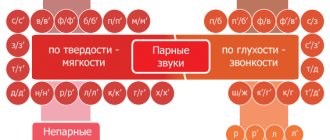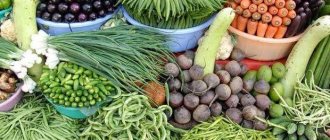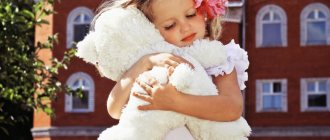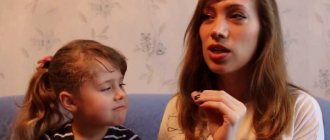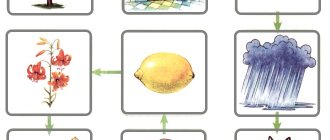On the topic: methodological developments, presentations and notes
I offer your attention a PowerPoint presentation on the lexical topic “Animals of hot countries.” I have selected illustrations of wonderful animals and a commentary on the most interesting features of their lives.
Material for organizing the speech environment of parents and children on the lexical topic: “Animals of hot countries.”
Lesson notes on the lexical topic “Animals of hot countries.”
automate the correct pronunciation of sounds; enrich the expressive vocabulary with words of antonyms and words of the same root; improve the grammatical structure of speech (formation of adjectives when writing.
Develop articulatory fine and gross motor skills; coordination of speech with movement, speech breathing, visual gnosis, spatial praxis, attention, memory, speech hearing. .
Develop articulatory fine and gross motor skills; coordination of speech with movement, speech breathing, visual gnosis, spatial praxis, attention, memory, speech hearing. .
Develop articulatory fine and gross motor skills; coordination of speech with movement, speech breathing, visual gnosis, spatial praxis, attention, memory, speech hearing. .
Source
Summary of a lesson on cognitive development in the preparatory group of the preschool educational institution “Animals of hot countries”
Summary of a lesson on cognitive development in the preparatory group of the preschool educational institution “Animals of hot countries”
Target. Expand children's understanding of animals in hot countries.
Tasks:
Educational:
— expand the pupils’ vocabulary;
— clarify and broaden children’s horizons about the life of animals in hot countries;
- learn to express your own opinions.
Educational:
- cultivate interest in the world around us and the ability to talk about its objects with adults and peers, listen carefully and complement each other’s answers.
Educational:
- develop interest in representatives of living nature.
Materials: pictures of animals from hot countries, signal cards, envelope, music.
Introductory part.
1. Greeting.
-Hello guys! My name is Victoria Sergeevna. Today we will go on a trip to the hot African desert. Let's turn off the gas and imagine. Yellow warm sands, scorching sun, no water, no greenery, drought, desert all around, but this is not only in Africa, also in India and America.
2. Surprise moment.
Let’s open our eyes, oh, look, while we were traveling, we got an envelope that said “From animals of hot countries,” and do you know any animals of hot countries? To find out what animals live there, we need to solve riddles, are you ready? Be careful!
Children sit on chairs in a semicircle near the board. Children close my eyes and we imagine hot countries.
Main part. 1. Guessing riddles.
The king of beasts is a big cat. He growls a little out of anger, He sleeps in the den, having eaten, He wears a mane, formidable... (lion) - Yes. This is a lion. What do you know about him?
A lion is a predator, stalking its prey. A lion has a large head and a fluffy mane, while a lioness has no mane. Leo is not afraid of anyone. As a rule, lionesses go hunting. They are more mobile, dexterous, and more successful in hunting. Leos are heavy, unhurried, lazy.
The meat obtained by the lionesses is first tasted by the owner. Therefore, he is always overweight, well-fed and does not hunt himself. When he goes hunting, he does not hide, does not attack his prey on the sly, but proudly warns: he growls - I’m out hunting, beware of the animals.
With his nose - a giant hose - he washes himself as if in the shower. This is a resident of hot countries. All the largest on land. Yes. This is an elephant. What do you know about him?
-The elephant is a mighty, very strong animal. Even a lion can't handle him. The most amazing thing about an elephant is its trunk. What does an elephant do with its trunk? Collects leaves and fruits from trees, tears grass, drinks, and can carry trees. It uses its trunk to protect itself from enemies, washes itself by taking water into its trunk and pouring water on itself from above. Who can harm an elephant? (A mouse, when an elephant is sleeping, climbs into its trunk and gnaws everything; and an ant, while an elephant sleeps, gnaws the soles of its feet, and the elephant cannot walk).
A fat man lives in Africa, he has a huge mouth, In the heat he sits in the water all day, thinking only about food, He chews tons of grass, insatiable... (hippopotamus) - Yes. This is a hippopotamus. What do you know about him?
-Hippopotamus is a huge and heavy animal. He spends most of his time in the water. The hippopotamus has huge teeth, but it feeds only on plants, tearing them off with its strong lips. Especially large fangs in the lower jaw. With this jaw he picks up algae from the bottom, like an excavator bucket. Although it seems that the hippopotamus is big and lazy, in fact it swims well and runs fast on land.
- Herbivorous, about a meter tall. You will meet me in the savannah. Instead of a nose there is a horn or two - the head can barely hold up. I can be black or white. I swim in water skillfully. If you see on the road... You will immediately recognize... a rhinoceros. - Yes. This is a rhinoceros. What do you know about him?
-The body of a rhinoceros is covered with thick skin of a dirty gray color. He has very poor eyesight. The rhinoceros feeds mainly on plant foods and prefers grass. On the plains, where grass grows in large quantities, they prefer to eat small shrubs, pulling them out by the roots.
Here is a living crane, an inhabitant of hot countries. Leaves and bananas are torn from multi-story trunks. (giraffe) - Yes. This is a giraffe. What do you know about him?
The giraffe is the tallest of all animals. Due to its long neck, it can become entangled in branches when feeding on tree leaves. The front legs are longer than the hind legs, and there are small horns on the head. The spots on the skin help camouflage among trees from predators. And the babies of a giraffe are called giraffes. A giraffe, like a camel, can also go without water for a long time during drought in the savannah.
-Well done, we met the animals of hot countries, and now let’s rest a little
Children get up from their chairs. I show the children the movements, and they repeat them on me, repeating the physical education lesson 2 times.
Dily - dily - dily - Crocodiles appeared (Children depict a dozing crocodile). Mots - mots - mots - Hippos appeared (They show how hippos walk, open their mouths wide). Af y - af y - af s Giraffes chew leaves (Reach up, depicting giraffes). Ny - ny - ny - Elephants splash water (They puff out their cheeks, as if taking in water, then splash). Yans - yans - yans - Monkeys are jumping along the branches (Children depict jumping monkeys). -Well done, let's sit back on the chairs.
3. Cubs.
And now I’ll check if you know the animals of hot countries, and I’ll name the animal, and you its baby, for example, a baby elephant, did you understand the task? Just don’t shout in unison, raise your hand, and I ask. The hippopotamus has... a hippopotamus The lion has... a lion cub The camel has... a baby camel The monkey has... a monkey The giraffe has... a baby giraffe.
And now I call an adult animal one, and you call cubs when there are many of them, for example, a turtle has many - turtles. A lion has a lot - ... lion cubs An elephant has a lot - ... calves A camel has a lot - ... camels A monkey has a lot - ... monkeys A hippopotamus has a lot - ... hippos A giraffe has a lot - ... giraffes.
4. This is who is so big.
-You are great, you answer correctly, and now I will name the animal, and you add a particle to its name, for example, ostrich - ostrich, lion - lion elephant - elephant giraffe - giraffe zebra - zebra crocodile - crocodile rhinoceros - rhinoceros hippopotamus - hippopotamus camel – camel
5. The most attentive
Guys, now I will give out signal cards to everyone: red and green, and I will say the following sentences, if you think that it is correct, we will raise the green signal card, and if it is incorrect, then the red one, and I will see how attentive you were. -Is Leo afraid of anyone? -Does an elephant have a long neck? -Can a giraffe go without water for a long time? -Is the body of a rhinoceros covered with spotted skin? -Is Africa a kingdom of cold? -Only lionesses go hunting? -Is the elephant the smallest animal on earth? - Well done, you remembered a lot of things.
Children pick up cards, thereby answering questions.
Final part. Reflection
Tell me who we met today? What did you like most? -We are all great guys, I say thank you, and now we take the chairs, put them in their place at the tables and go play!
Summary of the lesson on the development of lexical and grammatical categories “Animals of hot countries”
Elena Ivanovna Volodina
Summary of the lesson on the development of lexical and grammatical categories “Animals of hot countries”
Topic: “ Animals of hot countries ”
.
1) — Consolidate children’s knowledge about animals of southern countries , activate vocabulary on this topic;
— Improve the use of complex sentences in speech;
— Practice forming complex adjectives;
— Strengthen the agreement of adjectives with nouns in gender;
— Learn to select synonyms for adjectives;
- Practice selecting adjectives for nouns;
— Improve the ability to name baby animals ;
— Exercise in mastering the category of the instrumental case with the preposition “for”
;
— Strengthen the ability to compose a story and description according to a plan.
2) Develop memory , thinking, attention, facial expressions.
3) Cultivate interest in wildlife , love for animals .
Equipment: subject pictures depicting animals of hot countries and their cubs , pictures depicting the facial expressions of animals , a plan diagram for composing a story, a card with the designation of a word-attribute.
GCD on cognitive development "Animals of hot countries"
Lesson summary for the preparatory group
"Animals of hot countries"
Developed by Soboleva I.V.
Tasks:
Teach children to create a narrative composition - placing animals in a panorama of the African savannah. Continue to develop teamwork skills and abilities.
Develop the ability to use various artistic and visual materials: watercolors, wax pencils and a simple pencil and their combinations, giving the image greater expressiveness and a more accurate embodiment of the idea.
Improve technical drawing skills, using familiar image techniques, drawing in a certain sequence.
Encourage children's independent creativity and imagination, initiative, and the ability to make additions to the composition that correspond to a given theme.
Develop cooperation and interaction skills. Fostering goodwill, independence, initiative, and emotionality.
Developmental Environment: Africa Outline; "Choice Board"; paper, watercolor paints, paint brushes, glue stick, scissors.
Audience rows
: images of a kitten, lion cub, tiger cub, horse, zebra, giraffe.
Preliminary work:
Conversation about animals of hot countries
Reading poems “Monkey” by V. Jain, “Rhinoceros” by H. Bellock, “Giraffe”, “Lion cubs”, “Zebras” by S. Marshak, “Giraffe”, “Kangaroo” by B. Zakhoder.
Examination of reproductions and photographs of African landscapes.
Acquaintance with the works of animal artists.
Getting to know the appearance of exotic animals (photos, illustrations, visual teaching aids, atlases, encyclopedias, etc.)
Drawing a compositional basis (panorama of the African savannah).
Reading the book “The ABC of Animals” by Shalaeva.
Coloring book in the animal world
Origami "Giraffe"
Progress of the lesson
Organizational part.
Meeting the guests
Children stand in a semicircle - say their names and give each other a hand. Then they all say together: We will put palm to palm
And we will offer each other to be friends.
We will sing, practice, play,
To become kind, smart, friendly.
Educator
: Children, I received a strange package today, it contains some kind of map, on it are several animals from hot countries. And, excuse me, there is also a note here: “Dear guys, I am writing to you with a big request, to draw for me animals from hot countries.
I used to have a map with all the animals, but something bad happened to me. I was caught in a big storm on my ship, the waves were so strong that they hit my cabin and blurred the map. True, there are a few animals left, but I don’t remember at all what a giraffe, elephant, lion, camel, monkey, zebra, tiger look like. I first turned to animal artists, but they didn't remember exactly these animals. I need the card urgently, all the animals in Africa are sick.
LiveInternetLiveInternet
—Quote book
6 simple steps on how to buy medicines cheaper About the fact that in all pharmacies there are creatures for medicines.
Lexical topics. Space
lexical topic "Migratory birds".
How to calculate the amount of beads for a rope So, option 1 is “mathematical.”
First steps to intelligence. Developmental tasks for children from 4 to 5 years old. .
—Tags
—Categories
- everything for kindergarten (452)
- pictures, stencils (52)
- educational games (47)
- lexical topics (38)
- speech development (26)
- templates, medals (26)
- sliding folders (25)
- theater (24)
- drawing (21)
- design of a group, venue (20)
- GCD notes (19)
- alphabet, numbers (18)
- books, copybooks (18)
- ecology (11)
- mathematics (11)
- entertainment (9)
- file cabinets (9)
- for parents (8)
- applique, modeling (8)
- physical education minutes, outdoor games (8)
- speech therapy (7)
- crosswords, puzzles, riddles (7)
- tests, developmental tasks (5)
- interesting for children (5)
- literacy training (4)
- poems, stories, fairy tales (3)
- projects (3)
- video for children (3)
- fine motor skills (1)
- Traffic rules (1)
- knitting (151)
- for children (82)
- for women (70)
- napkins, tablecloths (19)
- useful to know (12)
- toys (12)
- Magazines (1)
- cooking (144)
- salads (35)
- baked goods (30)
- winter preparations (6)
- meat dishes (6)
- snacks, sandwiches (5)
- fish dishes (4)
- good to know (1)
- crafts (118)
- made of paper (34)
- made of satin ribbons (13)
- miscellaneous (12)
- from waste material (7)
- carnival costumes (3)
- made from natural materials (3)
- beaded (2)
- ribbon embroidery (2)
- newspaper tubes (1)
- interesting sites, links (39)
- miscellaneous (35)
- we treat ourselves (22)
- for home and garden (22)
- literature (18)
- for women (11)
- floriculture (11)
- everything for barbie (9)
- about the most interesting (5)
- congratulations (5)
- humor (2)
- lira (2)
- music (2)
- video (2)
- sewing (1)
- patterns (1)
- this is interesting (1)
- psychology (1)
—Applications
- Interpretation of dreams
Find out what the secret of your dream is - is it worth preparing for something bad or, conversely, the dream must come true. You will certainly find an interpretation of your dream, because the database already contains 47 - URGENT. MONEY
Unfortunately, anything can happen... And more often, for some reason, it always happens unexpectedly... A unique single form for applying for a loan to all banks at once will help save nerves, time and money! - Cheap flights
Favorable prices, easy search, no commission, 24 hours. Book now - pay later!
—Photo album
—Links
-Music
—Search by diary
—Subscription by e-mail
-Statistics
Lesson summary for the preparatory group “Animals of Hot Countries”
Summary of an integrated lesson for children of the preparatory group on familiarization with the outside world and speech development. Goal: To give children a basic understanding of the peculiarities of the geographical location of Africa. Objectives: To give children an idea of the relationships between living organisms and their habitat: desert, savanna, tropics.
Clarify children's ideas about animals in a hot country: appearance, characteristic features.
Create a cheerful mood, bring children joy, new experiences, pleasure. Attune children to each other, create a positive background in the group.
Organizing time. - Guys, look, this morning the postman brought me a mysterious letter. It is addressed to your group. Let's read it: Letter A young sailor in a sailor suit went out to the river bank. He took off his sailor suit like a sailor, took off his sea shoes, undressed like a sailor, he sneezed like a sailor, ran like a sailor And... dived like a soldier. Hello guys, you probably understand who is writing to you. I am a sea captain and I really love to travel, and I decided today to go to Africa. Do you want me to take you with me? — Tell me, what time of year is it now? (Spring) Yes, it’s spring outside, but frost, cold, snow, and today we will go with you to a very hot country and we will feel warm and cheerful. Guys, try to find Africa on the map yourself. (Children show) What is this (globe), let's see if Africa is on the globe? (there is) Look, what is that blue color around her? (Water) -How can we get to it? How can we go there? (on the ship) - That’s right, here’s our ship. LET'S TURN INTO SAILORS. Well, are you ready? Everyone aboard the ship. -Take your seats, stand three people in a row. -Listen to a good poem about Africa “Africa! Africa! Wonderland. We'll go to Africa, it's been waiting for us for a long time. We’ll see in hot Africa how animals live there... Let’s quickly go to Africa, the jungle is waiting for us!” - So we prepared for our journey. -Listen to our route: “We’ll sail to Zanzibar, We’ll get lost in the Sahara, We’ll see Kilimanjaro, We’ll take a walk with Hippo. And back along the Limpopo” - And so on the road. We swim to the song “Little Red Riding Hood” on the lyrics. A. Rybnikova / If it’s a long, long, long time, If it’s a long time along the path, If it’s a long time along the path To stomp, ride and run, Then, perhaps, then, of course, Then, probably, right, right, Then, perhaps, possible, possible, You can come to Africa. So we got to Africa. Let's leave our ship. We sit on the chairs. When depicting Africa on the map, they used a lot of yellow. What do you think the color yellow means? Africa is the kingdom of the world's hottest sun and hot sand. Africa is divided into desert, tropics, savannah, What is a desert, what do you think? (desert from the word empty, deserted) Let's take a short walk through the desert. — Look, what does the desert remind you of? Does it look like the sea? — these small hill-like hills are called dunes. Hot winds blow here, and the sand seems to flow from one place to another. -Let us now try to make a desert sea and see how the sand moves when the wind blows. “And guys, it hasn’t rained in the desert for years.” Do you think plants can live in this place? (answers) Educator: It turns out they can. Low plants with small leaves grow in the desert. How do they survive without water? (answers) They have very long roots. If you climb a 15-story building, their roots will reach the ground. Why do plants have such long roots? (get water that is deep underground). It seems there can be no animals in the desert. But there is one very hardy animal that lives in the desert, listen to my riddle and guess it with your eyes? “I’m a hunchbacked beast, the guys like me.” Who is this? (camel, showing illustrations) The camel is called the ship of the desert. Why do you think? (movements are smooth, like a ship) Camels carry heavy loads and people. These are very strong and hardy animals. Why aren't they hot in the desert? (Long thick hair protects the camel's body from the scorching rays of the sun). When the wind raises sand, it becomes difficult to breathe; the nostrils can be closed with the help of special muscles. And the ears are designed in such a way that sand does not get into them. They are small and covered with hairs. It almost never rains here. It is very hot during the day, sometimes fierce winds blow, drying out everything around. But after sunset the temperature drops sharply and it becomes very cold. Let's go further. Get on the camels, let's go further. (imitation trip, audio recording) It's hot in the desert! It's so hot that you could fry an egg on the sun-heated stones. I really want to relax somewhere near the water, in the shade. And suddenly a small lake appears in front of us, along the banks of which date palms grow (show illustration). - Let's get off our camels. This is an oasis with fertile soil, where gardens grow around springs or along rivers. Guys, let's relax on the shore of the lake! (yes) Let's take a swim (to relaxing music - swimming) - well, are you rested? We get on the camels and move on. Guys, the desert is left behind. Ahead - African savannah What is the soil in the savannah covered with? (grass). It is always thick here: dry yellow when there is no rain and green juicy after the rains. In some places there are giant trees. They are called Baobabs. Let's take a walk through the savannah and observe its inhabitants. - Let's get off our camels and let them graze. Well, here we are in the savannah, a menacing roar was heard. (Audio recording) What kind of animal is roaring? (lion, showing illustration). This is the king of beasts - the lion. Guys, a lion can be invisible, the way it hides among the yellow dry grass. Why is it important for a lion to be invisible? (he is a predator, stalking prey) It is very difficult to hide in the savannah, there are no dense thickets there. How do animals escape from predators? For example zebras. (they run fast) Riddle: “What kind of horses are they all wearing vests” (zebra). Here is a lioness hunting a zebra. The zebra runs away at high speed. However, the lioness is also a good runner and can catch up with the zebra. What's a zebra to do? (defend) Zebras' means of defense is to strike with their hooves. In flight, the zebra hits the enemy with its hind legs. Such a blow can greatly harm the predator. The zebra is very playful, a graceful animal, each is covered with stripes and they are not repeated. -Let's turn into zebras and draw a lot of stripes on ourselves? - Look who's coming to us? Educator: “Here he comes in with his head up, not because he is an important count, not because he has a proud disposition, but because he ... (giraffe) (showing an illustration or figure of an animal). The tallest animal on earth lives in the savannah. Why does the giraffe look proud and important? (he has a long neck and legs). The height of the giraffe is 6 meters, it is as tall as a 2-story house. Why does he have such a neck? (easily reaches the very tops of tall trees, tearing off leaves). - Do you want us to turn into giraffes? Look, he has an interesting color too. The largest bird in the world lives in Africa. They say about her: “And he doesn’t sing and doesn’t fly... Why do people consider Him a bird?” (B. Zakhoder) Who is this? (ostrich) Why is it considered a bird? (the ostrich has wings, but they serve as decoration). Ostriches also have one interesting feature: when they are afraid, they hide their heads in the sand. “There are a lot of horned animals in the zoo and in the forest. They all have horns on their heads, but he only has them on his nose” (rhinoceros, show) The rhinoceros is huge, from two to four meters in length, weighing up to 4 tons. Its body is covered with thick, dirty gray skin. What's on his forehead? (horn) And here are the African giants. Did you recognize them? (elephants, show) Do you think a lion will dare to attack an elephant? (no, an elephant is a powerful, very strong animal, a lion cannot cope with it). The most amazing thing about an elephant is its trunk. What is the elephant doing to them? (with the help of its trunk, the elephant picks leaves from trees, tears grass, drinks). Guys, let’s play the game “African House”. Each player is given cards with images of various African animals. One card for each participant. One of the players is appointed as the owner of a conditional little house (a rug or a children's house), and the others (or another) approach the little house and ask to come to his house (using the example of fairy tales): - Knock, knock, who lives in the little house? - I am a lion. And who are you? - And I am a Giraffe. Let me into the little house? “If you tell me how you are like me, then I’ll let you in.” I also have a tail. Zebra Rhinoceros Elephant Ostrich What part of Africa have we not been to yet? We were in the desert, we were in the savannah, - That's right, the tropics. There are many monkeys in the tropics, why? (Yes, that’s right, monkeys live in the tropics because there are a lot of trees, palm trees, coconuts, bananas, and dates. Monkeys jump, climb, jump over trees from palm to palm, clinging to vines. They have a very interesting and fun life. And ours the journey continues. - Let's remember what was drawn on the map in brown? (showing mountains) This is Kilimanjaro. (showing on the map). Translated from Swahili, this is the language of the peoples of Africa, a sparkling mountain, and why do you think? In the sun's rays it sparkles. Many rivers of Africa originate here: the Nile, the Congo, the Zambezi, the Limpopo. “And a log floats along the river, Oh, and it’s meaner. For those who fall into the river, the Nose will bite off...” (crocodile) (show) -In African rivers there are a lot of crocodiles. They trim their prey in the water. When zebras and antelopes approach a watering hole, they pounce on them. Crocodiles are very strong animals. Lemon and orange trees, coconut palms, bananas grow along the banks of the rivers. Well, why are you staying too long? Let's have a little rest ? I’m walking through Africa (walking in place), I notice as I walk, How a giraffe stretched its neck over a sea of lush grasses
(arms up, stretching). Above my head (bends to the sides with raised arms) the palm tree will rustle its leaves, but I have to squat (squats) to pick dates. Here is Velvichia, a tourist (arms are alternately extended forward): Left leaf, right leaf (arms to the sides).
And a huge gray elephant (circling his arms) sends us a bow (bending forward). We will finish the walk (walk in place) and hurry to our desks (sit in our seats). Oh, guys, while we were talking here. all the animals hid and left only their photographs as a souvenir. - What - apparently it’s time for us to return home to kindergarten? “We board our ship, take our seats and set off.” - So we arrived at the kindergarten, goodbye guys, (goodbye) For example, a lion has a big mane, so what is he like? (big maned) And the ostrich has thin legs, so what is it like? (thin-legged). If an ostrich only eats grass, what kind of ostrich is it? (herbivore) A crocodile swims in the water, so what is it like? (waterfowl) A giraffe has a long neck, so what is it like? (long-necked) An elephant has a long nose, so what is it like? (long-nosed) The crocodile dived into the water, and then out of the water... (surfaced) The ostrich buried its head in the sand, and then he dug it out.. (dug) And everyone moves differently. How does a crocodile move? (swims, walks) And the rhinoceros? (walks) And the turtle? (crawls) RESULT: Tell me, did you enjoy the trip? Guys, I’ll now give you signal cards: red and green. I will now say the following sentences. If you think it is correct, we raise a green signal card, and if it is incorrect, then a red one. So here we go: We traveled to Australia today. Africa is divided into 3 zones: desert, tropics, savannah. In Savana there are giant trees - baobabs. Africa is a kingdom of cold. Well done guys! This is where our journey ended. Goodbye! (say goodbye to guests)
